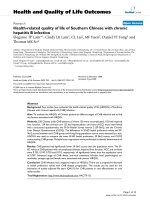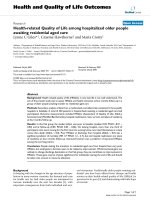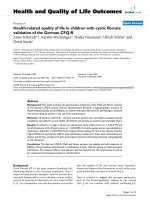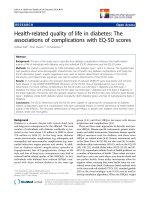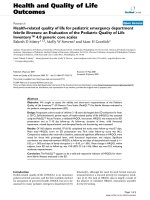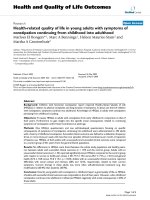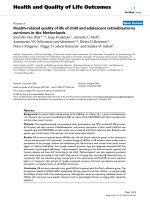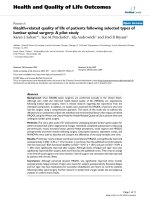báo cáo hóa học: " Health related quality of life in patients with anogenital warts" ppt
Bạn đang xem bản rút gọn của tài liệu. Xem và tải ngay bản đầy đủ của tài liệu tại đây (247.64 KB, 5 trang )
RESEARCH Open Access
Health related quality of life in patients with
anogenital warts
Sotirios A Koupidis
1*
, Electra Nicolaidou
1
, Maria Hadjivassiliou
1
, Stefanos Bellos
2
, Petros Skapinakis
2
,
Christina Stefanaki
1
, Helen Papadogeorgakis
1
and Andreas Katsambas
1
Abstract
Introduction: The health-related quality-of-life (HRQoL) instruments are an important tool for the evaluation of
medical outcomes. Sexually transmitted diseases (STDs) influence the patients’ life. We aimed to evaluate the
HRQoL in patients with anogenital warts at the time of and 1 month after the diagnosis.
Materials and methods: We used the short-form (SF)-36 questionnaire to compare the HRQoL of 91 patients with
anogenital warts to 53 control subjects with the same socioeconomic characteristics.
Results: There was no statistical difference in the overall HRQoL measurement between the anogenital wart
patients and controls. However, there was an improvement in the scales of vitality (65.22 ± 15.70 vs. 69.04 ± 14.1 1,
respectively; p < 0.05) and mental health (65.00 ± 20.09 vs. 69.43 ± 18.08, respectively; p < 0.05) in anogenital warts
patients between the time of diagnosis and 1 month later. Furthermore, there was a significant deterioration in the
scale of social functioning (73.47 ± 22.18 vs. 72.89 ± 19.28, respectively; p < 0.05). The small sample size is a
limitation of our study.
Conclusions: HRQoL does not appear to be influenced in anogenital wart patients, as measured by the generic
instrument SF-36. It is therefore important to develop specific instruments for the measurement of HRQoL in this
group of patients.
Introduction
Sexually transmitted diseases (STDs) are a group of dis-
eases that are transmitted through sexual intercourse
and are caused by a wide variety of pathogenic micro-
organisms. Until this day, more than 50 micro-organ-
isms have been recognised as a cause of STDs [1].
These diseases comprise a global challenge for health
care systems [2-4]. As STDs have reached epidemic
dimensions, they are recognized as a considerable threat
for public health. In addition, STDs are a cause of acute
illness, infertility, disability and death, with serious med-
ical and psychological consequences for millions of peo-
ple. The STD epidemic is associat ed with several
political, socioeconomic, behavioural, biochemical and
biomedical factors.
According to the World Health Organization and
Eurostat, there are 28 million new STD cases in Europe
per annum [3, 4]. The high est incidence is observed in
urban populations between 15-35 years of age [3,4].
Skin diseases may have a considerable effect on the
patient’ s quality-of-life (QoL). In 20-50% of patients
with skin diseases in secondary care, the decrease in the
QoL may be severe enough to classify the patient at risk
of developing severe psychosocial impairment or psy-
chiatric morbidity such as clinical depression [5-7].
Human papillomavirus (HPV) infection is the most
common cause of STDs worldwide with 50% of the
cases involv ing individuals aged 15-25 years [8,9]. More
than 100 different types of HPV have been identified
[10],30or40ofwhichcaninfectthemucosaandskin
of the anogenital area [11,12]. Clinically, anogenital
warts consist of epidermal and dermal papules or
nodules on the perineum, genitalia, crural folds and
anus.Theyvaryinsizeandcanformlarge,exophytic
(cauliflower-like) masses, especially in the moist envir-
onment of the perineum. Discrete 1-to 3 - mm s essile
warts may occur on the penile shaft. Warts may extend
* Correspondence:
1
Sexually Transmitted Infections Unit, 1
st
Department of Dermatology and
Venereology, University of Athens, “Andreas Sygros” Hospital, Athens, Greece
Full list of author information is available at the end of the article
Koupidis et al. Health and Quality of Life Outcomes 2011, 9:67
/>© 2011 Koupidis et al; licensee BioMed Central Ltd. This is an Open Access article distributed under the terms of the Creative
Commons Attribution License ( which permits unrestricted use, distribution, and
reproduction in any medium, provided the original work is properly cited.
internal ly into the vagina, urethra and perirectal epithe-
lium [1].
The health-related QoL (HRQoL) is very important
for the evaluation of medical outcomes. It is measured
with generic and disease-specific instruments. These
instruments are more important i n fields such as Der-
matology where mor tality is a relatively rare outcome.
There is only 1 specific instrument of measuring
HRQoL in patients with anogenital warts [13], which
has neither been properly adjusted, nor has i t been
widely translated to be clinically applied.
In the present study we aimed to evaluate the HRQoL
in patients with anogenital warts at the time of diagnosis
and at one-month follow-up using the generic instru-
ment short-form (SF)-36 [14,15].
Materials and methods
Between March and October 2008, a total of 240
patients diagnosed for the first time with anogenital
warts in the Sexually Transmitted Infecti ons Unit of the
“An dreas Sygros” Hospital for Skin and Venereal Dis-
eases were asked t o participate in the study. The study
consisted of completing the SF-36 questionnaire both at
the time of the diagnosis (t
0
)and1monthlater(t
1
). A
total of 53 healthy individuals who visited the hospital
for acquiring a health certificate comprised the control
group. The study participants comprising the control
group filled in the questionnaire only once.
The SF-36 is a generic, self-administered, m ulti-item
questionnaire measuring HRQoL, which is widely used
in health services research. It consists of 8 scales: Physi-
cal Functioning (PF), Role limitations due to Physical
problems (RP), Bodily Pain (BP), General Health ( GH),
Vitality (V), Social Funct ioning (SF), Role limitations
due to Emotional problems (RE) and Mental Health
(MH) [16-18]. Each scale ranges between 0 (worst
health) and 100 (best health). Furthermore, we com-
pared these results with the scores of SF-36 in patients
withotherdiseasesaswellasinthegeneralGreek
population, where this questionnaire has already been
adapted and evaluated [19-21].
This Ethical Committee of the Athens Hospital for
Skin Diseases “ Andreas Sygros” approved of the study.
A written informed consent was obtained from all
patients at the time of study entry.
The SF-36 scales were scored according to the docu-
men ted procedures [16]. Higher scores indicate a better
HRQoL. All the statistical analyses were performed with
STATA S/E 9.2. A p-value < 0.05 was considered as
showing significant results.
Results
A total of 91 patients c ompleted the study. The dro p-
outs and response rates are presented in Figure 1.
The sociodemographic characteristics of the study par-
ticipants are presented i n Table 1. The results of the 8
scales of SF-36 between the two time intervals in
patients with anogenital warts and in the control group
are presented in Table 2. In this Table, the scores of the
8 scales for the general population in Greece were also
included.
There was no difference in the scores of SF-36
between the patient and the control groups. In 5 of the
8 scales (PF, BP, GH, RP and RE) there was also no sig-
nificant difference in the 2 consecutive measurements of
the patient group. In contrast, there was a slight but sig-
nificant improvement in V and MH in the patient group
between the 2 t ime intervals. Furthermo re, there was a
slight but significant deterioration in SF i n the patient
group between the 2 time intervals.
Discussion
Our study showed that patients with anogenital warts
show an improvement in vitality and mental health 1
month after the establishment of the diagnosis. The pos-
sible reasons for this improvement may be the clinical
improvement or the clearing of the lesions after 1
mont h of treatment and the familiarity with the disease.
In contrast, our patients showed a slight but significant
Figure 1 Flow chart of patients during the study.
Koupidis et al. Health and Quality of Life Outcomes 2011, 9:67
/>Page 2 of 5
deterioration in social functioning. This may be the
result of feelings of guilt or shame for their condition
resulting to avoidance/restriction of social contacts.
According to the literature, patients with anogenital
warts suffer anxiety about the effect of the disease on
their sexual [13,22-27] and social relationships [13,2 3],
the stigma of having contracted a venereal disease
[25,27], the uncertain treatment success and time to
cure [13,22,23,26] and transmission of the disease to
others [13,22-25]. Several studies report that the
negative psychological effects of the disease are the most
difficult to treat [23,25,27]. They include feelings of
anger, fear caused by the relationship of HPV to cervical
cancer, guilt, de pression, self-loathing and worries about
the futu re [13,22-29]. Finally, the literature points to an
increased need for m ore information about the disease
and an i mproved communication between physicians
and patients [22,23,25,27].
Μore male than female patients were recruited in our
study. This is because moremalepatientswithSTDs
seek help for their condition in a hospital for Skin and
Venereal Diseases, like ours. Most women consult their
gynecologist for conditions like STDs. Furthermore, the
small number of women who attended our hosp ital did
not wish to participate in the study.
Our study has some limitations. Firstly, the sample
size was relatively small. Nevertheless, it was adequate
to reach significant conclusions. In addition, the popula-
tion of our study was patients attending a public, specia-
lized hospital; it did not include patients from general
hospitals, as well as patients from private practitioners.
It also did not include more wealthy patients who
usually prefer private hospitals to maintain t heir anon-
ymity, as wel l as those women who are treated by other
speci alists (e.g. gynecologists). Therefore one sh ould not
generalize the results in such groups if patients.
Based on the above-mentioned arguments, a credible
questionnaire/tool is required to measure psychological
burden on patients with anogenital warts. The develop-
mentofaspecificquestionnaireformeasuringHRQoL
in patients with anogenital warts, as described by Badia
and associates [13], c ould demonstrate the degree of
psychological/social/physical burden of this condition to
patients. In addition, use of this questionnaire in differ-
ent populations (i.e. with different religions, ethical and
social beliefs, etc.) will help in drawing conclusions
about the relative burden of the condition according to
the patients’ background.
There are several clinical implications of our study.
Firstly, by use of the questionnaire, patients are directly
involved and may participate in their treatment more
actively. This way the emphasis is shifted from disease-
oriented to patient-oriented treatment. For this reason
assessment of the HRQoL has been routinely used as a
measure of efficacy in clinical practice and research [30].
Additionally, there is the potential for physicians to
receive feedback from the patients regarding the e ffec-
tiveness of the treatment and their degree of satisfaction.
Furthermore, the use of the SF-36 in specific patient
subgroups with different religious or cultural back-
ground compared to the rest of the Greek population (e.
g. Muslims, refugees, etc.) may have a different effect on
HRQoL. Finally, the emplo yment of these tools will
enable the more objective verification of the success or
Table 1 Socio-demographic characteristics of the study
participants
Socio-demographic characteristics of the study participants
Patients
(n = 91)
Controls
(n = 53)
Age, Mean 26.4 26.3
[95% Confidence Interval] [25.0 - 27.9] [24.5 - 28.2]
Gender %
Male 73 74
Female 27 26
Age group %
<20 7.7 9.4
20-29 71.4 67.9
30-39 14.3 17.0
40-55 6.6 5.7
Marital status %
Married 89.01 88.68
Single 6.59 5.66
Divorced 3.30 5.66
Widowed 1.10 0
Education %
Primary 1.10 1.89
Secondary 47.25 33.97
University 38.46 49.05
MSc/PhD 8.79 13.20
No answer 4.40 1.89
Household income %
< 500€ 14.29 9.43
501€ - 1000€ 30.77 26.41
1001€ - 2000€ 23.08 33.96
2001€ - 3000€ 9.89 9.43
3001€ - 5000€ 8.79 16.99
< 5001€ 8.79 1.89
No answer 4.40 1.89
Working status %
Working 61.54 62.26
Not working (unemployed, student,
housewifery)
36.26 35.85
No answer 2.20 1.89
Koupidis et al. Health and Quality of Life Outcomes 2011, 9:67
/>Page 3 of 5
failure of the therapeutic approach a nd will also impli-
cate the patient himself/herself in the management of
the condition.
Conclusions
In conclusion, we found that there was an improve-
ment in the scales of vitality and mental health and a
deterioration in the scale of social functioning in ano-
genital warts patients between the time of diagnosis
and initiation of treatment and one month later. The
small sample size however is a limitation of our study.
HRQoL does not appear to be influenced in anogenital
wart patients, as measured by the generic instrument
SF-36. It is important to develop specific instruments
for the measurement of HRQoL in this group of
patients.
Conflict of interest
The authors declare that they have no competing
interests.
Authors’ contributions sections
SK participated in the design of this ancillary work,
reviewed the literature. He also participated in generat-
ing and gather ing the data the data and in writing the
manuscript. EN participated in generating the data and
in writing the manuscript. MH participated in the
design of the study and in writing the manuscript. SB
Performed the statistical analysis, and drafted the manu-
script. PS made critical comments and helped in the
interpretation of the results. CS participated in
generating and in ga thering the data of the study. HP
participated in generating and gathering the data of the
study. AK participated in the design and coordination of
the study. All authors collabora ted interactively, and
read and approved the final version.
Acknowledgements
The authors would like to thank the medical staff of Sexually Transmitted
Infections Unit, 1
st
Department of Dermatology and Venereology, University
of Athens, “Andreas Sygros” Hospital, Athens, Greece for their help and
support.
Author details
1
Sexually Transmitted Infections Unit, 1
st
Department of Dermatology and
Venereology, University of Athens, “Andreas Sygros” Hospital, Athens, Greece.
2
Department of Psychiatry, Medical School, University of Ioannina, Greece.
Received: 16 February 2011 Accepted: 16 August 2011
Published: 16 August 2011
References
1. Eichmann AR: Other venereal diseases Fitzpatrick’s Dermatology in
General Medicine.Edited by: I Freedberg, A Eisen, K Wolff, KF Austen, LA
Goldsmith, SI Katz, TB Fitzpatrick , 6 2003.
2. Chesson HW, Blandford JM, Gift TL, Tao G, Irwin KL: The estimated direct
medical cost of sexually transmitted diseases among American youth
2000. Perspect Sex Reprod Health 2004, 36:11-19.
3. WHO: Global prevalence and incidence of selected curable sexually
transmitted infections. 2010 [ />htm], Accessed on October 10.
4. Eurostat: 2010 [ Accessed on
October 10.
5. Picardi A, Abeni D, Renzi C, Braga M, Puddu P, Pasquini P: Increased
psychiatric morbidity in female outpatients with skin lesions on visible
parts of the body. Acta Derm Venereol 2001, 81:410-414.
6. Picardi A, Abeni D, Melchi CF, Puddu P, Pasquini P: Psychiatric morbidity in
dermatological outpatients: an issue to be recognized. Br J Dermatol
2000, 143:983-991.
Table 2 HRQoL measured with - SF-36
HRQoL measured with - SF-36
Scales Patients
(n = 91, t
0
)
Patients
(n = 91, t
1
)
Controls
(n = 54)
General population of Greece (n = 1007)
Score
Physical Functioning (PF) 88.72
(SD: 16.63)
91.57
(SD: 14.89)
88.39
(SD: 13.32)
79.5
(SD: 26.3)
NS
Bodily Pain (BP) 82.56
(SD: 20.35)
83.34
(SD: 22.27)
78.11
(SD: 23.35)
72.4
(SD: 31.9)
NS
General Health (GH) 64.22
(SD: 15.83)
66.36
(SD: 15.06)
70.66
(SD: 18.02)
66.7
(SD: 23.8)
NS
Role Physical (RP) 82.78
(SD: 28.21)
83.14
(SD: 26.78)
84.43
(SD: 25.11)
78.6
(SD: 38.7)
NS
Role Emotional (RE) 81.11
(SD: 32.79)
83.13
(SD: 28.92)
83.64
(SD: 28.95)
81.2
(SD: 36.6)
NS
Vitality (V) 65.22
(SD: 15.70)
69.04
(SD: 14.11)
68.68
(SD:15.25)
66,0
(SD: 22.5)
p < 0.05
Social Functioning (SF) 73.47
(SD: 22.18)
72.89
(SD: 19.28)
75.70
(SD:21.98)
81,3
(SD: 28.7)
p < 0.05
Mental Health (MH) 65.00
(SD: 20.09)
69.43
(SD: 18.08)
66.22
(SD:19.43)
68,2
(SD: 21.2)
p < 0.05
NS: not significant.
Koupidis et al. Health and Quality of Life Outcomes 2011, 9:67
/>Page 4 of 5
7. Picardi A, Adler DA, Abeni D, Chang H, Pasquini P, Rogers WH, Bungay KM:
Screening for depressive disorders in patients with skin diseases: a
comparison of three screeners. Acta Derm Venereol 2005, 85:414-419.
8. Nicolaidou E, Katsambas AD: The burden of human papillomavirus
infections and the expected impact of new vaccines. Expert Rev Vaccines
2007, 6:475-477.
9. Ho GY, Bierman R, Beardsley L, Chang CJ, Burk RD: Natural history of
cervicovaginal papillomavirus infection in young women. N Engl J Med
1998, 338:423-428.
10. Benenson A: Control of communicable diseases manual. Washington DC:
American Public Health Association; 1995.
11. Kjaer SK, Chackerian B, van den Brule AJ, Svare EI, Paull G, Walbomers JM,
Schiller JT, Bock JE, Sherman ME, Lowy DR, Meijer CL: High-risk human
papillomavirus is sexually transmitted: evidence from a follow-up study
of virgins starting sexual activity (intercourse). Cancer Epidemiol
Biomarkers Prev 2001, 10:101-106.
12. Smith JS, Lindsay L, Hoots B, Keys J, Franceschi S, Winer R, Clifford GM:
Human papillomavirus type distribution in invasive cervical cancer and
high-grade cervical lesions: a meta-analysis update. Int J Cancer 2007,
121:621-632.
13. Badia X, Colombo JA, Lara N, Llorens MA, Olmos L, Sainz de los Terreros M,
Varela JA, Vilata JJ: Combination of qualitative and quantitative methods
for developing a new Health Related Quality of Life measure for
patients with anogenital warts. Health Qual Life Outcomes 2005, 3:24.
14. Aaronson NK, Acquadro C, Alonso J, Apolone G, Bucquet D, Bullinger M,
Bungay K, Fukuhara S, Gandek K, Keller S: International Quality of Life
Assessment (IQOLA) Project. Qual Life Res 1992, 1:349-351.
15. Garratt A, Ruta D, Abdalla M, Buckingham J, Russell I: The SF-36 health
survey questionnaire: an outcome measure suitable for routine use
within the NHS? Br Med J 1993, 306:1440-1444.
16. Ware J, Snow K, Gandek B, Kosinski M: SF-36 Health Survey Manual and
Interpretation Guide. Boston: Medical Center; 1993.
17. Ware J: SF-36 health survey update. Spine 2000, 25:3130-3139.
18. Alonso J, Ferrer M, Gandek B, Ware JE Jr, Aaronson NK, Mosconi P,
Rasmussen NK, Bullinger M, Fukuhara S, Kaasa S, Leplege A, IQOLA Project
Group: Health-related quality of life associated with chronic conditions
in eight countries: results from the International Quality of Life
Assessment (IQOLA) Project. Qual Life Res 2004, 13:283-298.
19. Pappa E, Kontodimopoulos N, Papadopoulos AA, Niakas D: Assessing the
socio-economic and demographic impact on health-related quality of
life: evidence from Greece. Int J Public Health 2009, 54:241-249.
20. Anagnostopoulos F, Niakas D, Pappa E: Construct validation of the Greek
SF-36 Health Survey. Qual Life Res 2005, 14:1959-1965.
21. Pappa E, Kontodimopoulos N, Niakas D: Validating and norming of the
Greek SF-36 Health Survey. Qual Life Res 2005,
14:1433-1438.
22. Maw RD, Reitano M, Roy M: An international survey of patients with
genital warts: perceptions regarding treatment and impact on lifestyle.
Int J STD AIDS 1998, 9:571-578.
23. Maggino T, Casadei D, Panontin E, Fadda E, Zampieri MC, Dona MA,
Dona MA, Solda M, Altoe G: Impact of an HPV diagnosis on the quality of
life in young women. Gynecol Oncol 2007, 107:S175-179.
24. Graziottin A, Serafini A: HPVinfection in women: psychosexual impact of
genital warts and intraepithelial lesions. J Sex Med 2009, 6:633-645.
25. Clarke P, Ebel C, Catotti DN, Stewart S: The psychosocial impact of human
papillomavirus infection: implications for health care providers. Int J STD
AIDS 1996, 7:197-200.
26. Sheppard S, White M, Walzman M: Genital warts: just a nuisance?
Genitourin Med 1995, 71:194-195.
27. Hammarlund K, Lundgren I, Nystrom M: To contract genital warts - a risk
of losing love? Experiences of Swedish men living with genital warts. Int
J Mens Health 2007, 6:100-114.
28. Kitchener HC: The role of human papillomavirus in the genesis of
cervical cancer. Cancer Treat Res 1994, 70:29-41.
29. Walboomers JM, Jacobs MV, Manos MM, Bosch FX, Kummer JA, Shah KV,
Snijders PJ, Peto J, Meijer CJ, Muñoz N: Human papillomavirus is a
necessary cause of invasive cervical cancer worldwide. J Pathol 1999,
189:12-19.
30. Kondo-Endo K, Ohashi Y, Nakagawa H, Katsunuma T, Ohya Y, Kamibeppu K,
Masuko I: Development and validation of a questionnaire measuring
quality of life in primary caregivers of children with atopic dermatitis
(QPCAD). Br J Dermatol 2009, 161:617-625.
doi:10.1186/1477-7525-9-67
Cite this article as: Koupidis et al.: Health related quality of life in
patients with anogenital warts. Health and Quality of Life Outcomes 2011
9:67.
Submit your next manuscript to BioMed Central
and take full advantage of:
• Convenient online submission
• Thorough peer review
• No space constraints or color figure charges
• Immediate publication on acceptance
• Inclusion in PubMed, CAS, Scopus and Google Scholar
• Research which is freely available for redistribution
Submit your manuscript at
www.biomedcentral.com/submit
Koupidis et al. Health and Quality of Life Outcomes 2011, 9:67
/>Page 5 of 5
